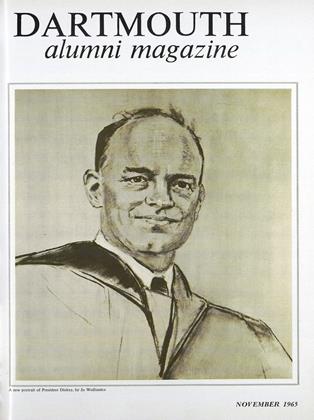Dartmouth engineers who have been studying radio phenomena called "whistlers" from ten earthbound stations from Labrador to Antarctica now have a listening post in space.
Among scientific instruments carried by the OGO-C satellite which blasted off from Vandenberg Air Force Base in California on October 14 was a special radio receiver designed by engineers of Dartmouth's Radiophysics Laboratory.
The receiver's function is to record certain very low frequency radio signals that occur in nature and have puzzled scientists for years. These non-man-made, audio-frequency signals are classified into two categories:
(1) "Whistlers," sounds of descending pitch believed to be generated by radiation from lightning strokes that have penetrated the ionosphere, and
(2) The more mysterious "ionospherics" whose origins are not yet clear. These include "sliders" (falling whistler-like tones), "surf," "hisses" and "hooks" (falling tones with an abrupt rise at the end), all classified according to the sounds they produce in the output speakers or earphones.
The Dartmouth instruments are part of continuing studies of these phenomena being carried out under the direction of Millett G. Morgan, Professor of Electrical Engineering and director of the Radiophysics Laboratory at Dartmouth's Thayer School of Engineering, and Thomas Laaspere, Associate Professor of Engineering. The studies are being supported by grants from the National Science Foundation and the National Aeronautics and Space Administration.
Since the studies concern the ionosphere, the "mirror" that reflects radio waves back to earth, the data received are expected to be valuable in longrange communications and to man's knowledge of the universe.
The OGO satellite (for Orbiting Geophysical Observatory) did not assume the planned orbit exactly. Its apogee or farthest distance from earth will be about 800 miles instead of 600. However, this will be an advantage to the Dartmouth experiments, the engineers said.
The observations from space will be coordinated with those made at the "Whistlers East" chain of ground receiving stations. These ten listening stations extend along the 65th parallel from Labrador to Antarctica and are part of a Dartmouth-coordinated ionospheric radio communications research program under way since 1957.
The whistlers themselves have acted as inexpensive space probes. Close observation of their arching paths cut through the ionosphere has shown, for instance, that space is not as "empty" as was previously thought. Measurements using these low-frequency signals showed about a thousand electrons in each cubic inch of space even at a distance of 16,000 miles.
Prof. Morgan
 View Full Issue
View Full Issue
More From This Issue
-
 Feature
FeatureGraduate Study—Past and Present
November 1965 By PROF. LEONARD M. RIESER '44, -
 Feature
FeatureThe Conscience of Liberal Learning
November 1965 -
 Feature
FeatureAn Exciting 20-Year Forward March
November 1965 -
 Feature
FeatureDartmouth's First Lady
November 1965 By MARGARET BECK McCALLUM -
 Feature
FeatureCHAIRMAN'S REPORT 1964-1965 CAMPAIGN
November 1965 By Rupert C. Thompson, Jr. '28 -
 Feature
FeatureFishing the Grant with John Dickey
November 1965 By EDWARD WEEKS, LITT.D. '50,
Article
-
 Article
ArticleMEETING OF THE ALUMNI COUNCIL
December, 1914 -
 Article
ArticlePulling Answers Out of the Air
June 1953 -
 Article
ArticleThe Fraternity "Problem"
JANUARY, 1928 By "F. Clark S. '30." -
 Article
ArticleCross Country
November 1961 By DAVE ORR '57 -
 Article
ArticleLaureled Sons
November 1944 By H. F. W. -
 Article
ArticleThayer School
June 1944 By William P. Kimball '29

